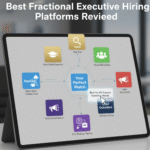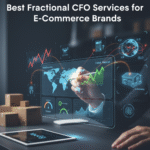Charting New Territories in Private Equity
In the dynamic world of private equity, where the landscape is as challenging as it is rewarding, the ability to expand external networks and drive business innovation is not just an asset – it’s a necessity. This is your compass and map to CFO strategies for building networks and driving innovation.
For CFOs and leaders in PE-backed firms, the journey is akin to that of an explorer, venturing beyond familiar borders to discover new opportunities and forge valuable alliances. In this realm, your success is not solely defined by internal operations but equally by how effectively you connect with the world outside – from harnessing the power of financial networking to tapping into the wellspring of market intelligence.

This article embarks on a journey through five pivotal tactics that are instrumental in building networks and driving innovation. These tactics are your tools for building bridges with peers, understanding market dynamics, and bringing fresh, innovative ideas to the table. Whether it’s leveraging the insights gained from portfolio gatherings, engaging in digital communities for knowledge exchange, or applying competitor analysis for strategic advantage, each tactic opens the door to new possibilities and pathways for growth.
1. Leverage Portfolio Gatherings
Financial Networking Opportunities:
Portfolio gatherings like conferences and seminars are invaluable for PE-backed CFOs. These events provide a unique platform to network with peers, investors, and industry experts. Attending these gatherings is not just about forming connections; it’s about immersing yourself in a community that shares similar challenges and goals. Use these opportunities to discuss industry trends, share experiences, and gain insights from others who are navigating the same complex financial landscapes. Networking in these settings can lead to long-term professional relationships that are mutually beneficial, offering a support system and sounding board for strategic ideas.

Knowledge Exchange and Learning:
Portfolio gatherings often feature discussions on the latest industry developments, regulatory changes, and emerging technologies. Participate actively in these discussions to stay updated on the factors that are shaping your industry. Engaging in workshops and panel discussions can also provide deeper insights into topics such as risk management, digital transformation, or ESG (Environmental, Social, and Governance) investing trends.
Cross-Portfolio Synergies:
One of the key benefits of portfolio gatherings is the opportunity to explore synergies across different companies within the same investment portfolio. These events allow you to identify potential areas for collaboration, such as shared services, joint ventures, or collective bargaining for better terms with suppliers. Collaborating with other portfolio companies can lead to significant cost savings, improved efficiencies, and even joint initiatives that can drive innovation and growth.
Best Practices and Shared Experiences Building Networks and Driving Innovation:
Use these gatherings to share your successes and learn from the experiences of others. Discussing what has worked and what hasn’t in different contexts can provide valuable lessons and prevent repeating mistakes. This exchange of best practices is particularly beneficial in a PE-backed environment, where companies often face similar operational and financial challenges.
Building a Community of Support:
Beyond the immediate benefits of financial networking and learning, these gatherings help in building a community of support among CFOs and finance professionals. This community can be a source of advice, mentorship, and support as you navigate the complexities of your role. Establishing strong connections with your peers can also open doors to future collaborations and opportunities.
Follow-Up and Continuous Engagement:
After attending these gatherings, make sure to follow up with the contacts you’ve made. This could be through LinkedIn connections, emails, or even setting up one-on-one meetings to continue the conversations. Keeping the communication lines open ensures that the benefits of the gathering continue long after the event has concluded.
2. Foster Digital Communication Channels

Leverage Technology for Community Building:
In today’s digital age, technology plays a crucial role in facilitating communication and collaboration. As a PE-backed CFO, harnessing the power of digital platforms like Slack, Microsoft Teams, or specialized finance forums is essential for creating a vibrant community of peers. These platforms can serve as a hub for knowledge sharing, problem-solving, and support. They offer a space where finance professionals can connect, discuss challenges, and share insights, regardless of their geographical locations. By establishing dedicated channels or groups on these platforms, you can foster a sense of community and collaboration among finance professionals within your organization and across your professional network.
Real-Time Communication and Collaboration:
Digital communication tools enable real-time interaction, which is invaluable for quick decision-making and problem-solving. They allow team members to ask questions, share updates, and provide feedback instantaneously. This immediacy can be particularly beneficial in a PE-backed environment, where financial decisions often need to be made swiftly and efficiently.
Ongoing Learning and Development:
Encourage a culture of ongoing learning and development within these digital channels. Share relevant articles, industry reports, webinars, and training materials that can help team members stay abreast of the latest best practices, industry trends, and technological advancements. Organize virtual meetups or Q&A sessions with industry experts to facilitate learning and engagement.
Interactive Knowledge Sharing:
Create interactive knowledge-sharing opportunities, such as virtual brainstorming sessions, online workshops, or ‘Ask me Anything’ (AMA) sessions with senior finance leaders. These activities can help disseminate knowledge and foster a culture of open communication and continuous learning.
Feedback and Improvement:
Use these digital channels to gather feedback on various CFO strategies, reports, or initiatives. Encourage team members to share their thoughts and suggestions, creating a collaborative environment where everyone feels valued and heard. This feedback can be instrumental in refining processes, improving financial models, and developing more effective CFO strategies.
Building Building Networks and Driving Innovation in a Digital Community Culture:
Finally, focus on building a culture that embraces digital communication as a key part of the finance function. This involves not just using digital tools for communication but also embedding them into the everyday workflow of the finance team. Encourage team members to actively participate in these digital communities, share their experiences, and learn from each other. By doing so, you can create a more connected, informed, and agile finance team well-equipped to navigate the challenges of the PE-backed environment.
3. Analyze Competitors’ Financial Health
Market Intelligence:
In the competitive landscape of private equity, understanding your market position relative to your competitors is crucial. As a PE-backed CFO, make it a routine practice to delve into your public market competitors’ financial statements and reports. This analysis should go beyond just a cursory glance; it involves a deep dive into their revenue streams, cost structures, profit margins, and investment strategies. Doing so gives you valuable insights into industry trends, financial benchmarks, and best practices. This market intelligence is about keeping tabs on competitors and understanding the broader market dynamics that could impact your business.
Benchmarking and Trend Analysis:
Use this information to benchmark your company against industry leaders. Look at key financial ratios and performance indicators such as return on investment, operating margins, or customer acquisition costs. Analyzing these metrics can reveal where your company stands in comparison to the competition and highlight areas for improvement. Additionally, trend analysis can help you identify industry trends, such as shifts in consumer behavior, new revenue models, or changes in cost structures.
Strategic Application:
The insights gained from this competitive analysis should be directly applied to your company’s strategic planning. This might involve identifying new market opportunities that competitors are capitalizing on or areas where your company can gain a competitive edge. For instance, if competitors are successfully venturing into new geographical markets or product lines, it might indicate a potential opportunity for your company. Conversely, understanding the challenges or failures of competitors can help you avoid similar pitfalls.
Informed Decision-Making:
Armed with this comprehensive market intelligence, you can make more informed decisions regarding investments, cost management, and strategic initiatives. For example, if competitors are achieving higher margins through technological and business innovations or operational efficiencies, it might be an indication for your company to explore similar avenues. Similarly, if competitors are struggling in certain areas, it might signal a need for caution or a strategic reevaluation in those areas.
Adapting to Market Changes:
Regular competitor analysis keeps your company agile and responsive to market changes. By staying informed about your competitors’ financial health and CFO strategies, you can quickly adapt your strategies to maintain or improve your competitive position. This agility is particularly important in the PE-backed environment, where market dynamics can change rapidly.
Collaboration with Other Departments:
Collaborate with other departments, such as marketing, sales, and operations, to maximize the impact of this analysis. Their insights and perspectives can provide additional context to the financial data, leading to a more holistic understanding of the competitive landscape.
4. Initiate Peer Advisory Groups
Collaborative Networks:
Building networks and driving innovation with peers is invaluable in the unique and often high-pressure world of private equity. As a PE-backed CFO, proactively create or join peer advisory groups that consist of other CFOs in similar roles. These groups serve as a platform for discussing the unique challenges and opportunities of managing PE-backed companies’ finances. They provide a safe and confidential environment to share experiences, strategies, and advice. These networks can be formed within your industry or across different sectors, offering diverse perspectives and insights.

Benefits of Diverse Perspectives:
Interacting with CFOs from various industries can give you insights into how different sectors tackle common financial and operational challenges. This diversity can spark innovative thinking and provide solutions that you might not have considered within the confines of your own industry.
Focused Discussions:
To maximize the effectiveness of these peer advisory groups, organize meetings around specific themes or challenges. This could include topics like cash flow management in a volatile market, strategies for efficient capital allocation, navigating regulatory changes, or implementing new financial technologies. By focusing on particular themes, the discussions can be more targeted, allowing members to delve deeply into each subject and come away with practical and actionable ideas.
Structured Yet Flexible Format:
While having a structured agenda is important, it also allows flexibility in discussions to enable members to bring up urgent issues they are facing. This balance ensures that the group addresses both planned topics and current, pressing challenges.
Sharing Success Stories and Lessons Learned:
Encourage members to share their success stories and lessons learned from past experiences. This can be incredibly valuable, as it provides real-life examples of CFO strategies or solutions that have been effective in similar situations.
Regular Meetings and Communication:
Establish a regular cadence for monthly or quarterly meetings to ensure consistent engagement and ongoing support. Additionally, consider setting up a digital communication channel, like a private LinkedIn group or a dedicated email list, for members to stay in touch, share resources, and seek advice between meetings.
Guest Speakers and Experts:
Occasionally invite guest speakers, such as industry experts, seasoned executives, or technical specialists, to provide insights on specific topics. Introducing new perspectives and expert knowledge can add significant value to the group.
Confidentiality and Trust:
Establishing a foundation of confidentiality and trust within the group is crucial. Members should feel comfortable sharing openly without concern for information being shared outside the group. This trust is fundamental for honest and productive discussions.
5. Integrate Personal Expertise with PE CFO Strategies
Strategic Vision:
As a PE-backed CFO, you bring unique skills, experiences, and perspectives to the table. It’s essential to balance the tried-and-true methods of the standard private equity (PE) playbook with your personal expertise and vision. This means following established PE strategies and tailoring them to fit your company’s specific needs, culture, and objectives. Your strategic vision should consider the company’s long-term goals, its position in the market, and the specific challenges it faces. By blending PE methodologies with your insights, you can develop a more nuanced and effective strategy that drives sustainable growth and value creation.
Leveraging Unique Insights:
Your background and experiences can provide valuable insights into areas such as risk management, innovation, market expansion, or operational efficiency. Use this knowledge to inform strategic decisions, such as entering new markets, investing in technology, or restructuring operations. Your unique perspective can help identify opportunities and risks that might not be apparent through a standard PE lens.
Innovative Solutions:
In the dynamic world of private equity, sticking solely to traditional methods may not always yield the best results. Don’t hesitate to propose innovative solutions and approaches, especially when they can provide a competitive edge or address specific challenges more effectively. This could involve adopting new technologies, exploring unconventional partnerships, or implementing creative financial structures. Innovation is not just about new products or services; it’s also about thinking differently about processes, management practices, and business models.
Challenging the Status Quo:
Part of integrating your expertise with PE strategies involves being willing to challenge the status quo when necessary. If traditional PE approaches are not aligned with your company’s best interests, it’s important to voice your concerns and propose alternatives. This requires a deep understanding of both the PE framework and your company’s unique context.
Collaboration and Persuasion:
Successfully integrating your expertise with PE strategies often requires collaboration and persuasion, especially when proposing changes to established plans. Work closely with your team, investors, and other stakeholders to communicate your vision and the rationale behind your proposed strategies. Use data and your past experiences to support your arguments and demonstrate the potential benefits of your approach.
Continuous Adaptation and Learning:
Integrating your expertise with PE strategies is an ongoing process. It requires continuous adaptation and learning as market conditions change, new technologies emerge, and your company evolves. Stay informed about industry trends and best practices, and be prepared to adjust your strategies in response to new information and insights.
Mastering the Art of External Engagement and Innovation in PE
As we wrap up our discussion on the essential tactics for building networks and driving innovation with external networks in PE-backed firms, it becomes clear that the role of a PE-backed CFO involves navigating a complex and ever-changing landscape. Each tactic we’ve explored offers practical tools for effectively managing private equity challenges and opportunities.
By actively participating in portfolio gatherings, you gain valuable insights and build meaningful connections within your industry. Embracing digital communication channels allows you to stay abreast of rapid changes and maintain crucial connections in today’s fast-paced business innovation environment. Analyzing competitors’ financial health gives you a clearer understanding of market dynamics, helping you identify opportunities and potential risks.
Initiating peer advisory groups creates a platform for shared learning and mutual support, enhancing your strategic decision-making. Integrating your expertise with established PE strategies enables you to tailor your approach, ensuring your company’s unique needs and goals are met.
In applying these tactics, remember that your role goes beyond traditional financial management. You are a key driver of innovation and strategic networking in the realm of private equity. Equipped with these strategies, you are prepared to guide your firm through new challenges, uncover innovative solutions, and build robust networks that contribute to your company’s ongoing success.
Let these tactics be your guide as you continue to navigate the dynamic and multifaceted world of private equity, driving growth and innovation in your firm.
Like NeoGig‘s article 5 Essential Strategies for Building Networks and Driving Innovation in Private Equity Firms?
5 Effective Internal Management Strategies for PE-Backed CFOs
Why Hire a Fractional Leader: Traditional Consulting vs. Fractional Leadership







